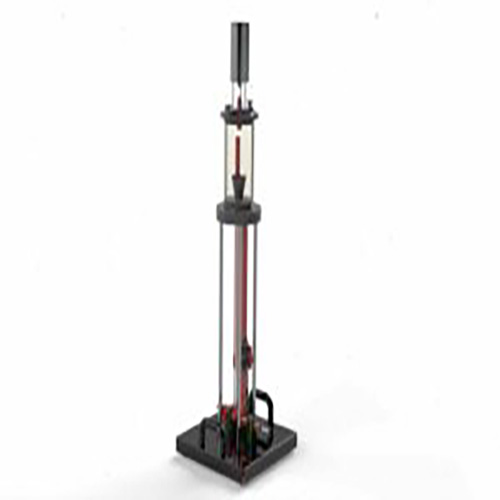FM-416 | Osborne Reynolds Apparatus
- Visualisation of laminar and turbulent flow in the Osborne Reynolds experiment
- Water as flowing medium and ink as contrast medium
- Vertical glass pipe section
- Water tank with glass beads to stabilise the flow
- Flow rate in the pipe section can be adjusted via a valve
- Flow rate determined by FM-430 Hydraulic Bench
- Water supply using FM-430 Hydraulic Bench or via laboratory supply
Description
Technical Specification
Media
The Osborne Reynolds experiment is used to display laminar and turbulent flows. During the experiment it is possible to observe the transition from laminar to turbulent flow after a limiting velocity. The Reynolds number is used to assess whether a flow is laminar or turbulent. The streamlines during laminar or turbulent flow are displayed in colour with the aid of an injected contrast medium (ink). The experimental results can be used to determine the critical Reynolds number.
The experimental unit consists of a transparent pipe section through which water flows, with flow-optimised inlet. A valve can be used to adjust the flow rate in the pipe section. Ink is injected into the flowing water. A layer of glass beads in the water tank ensures an even and low-turbulence flow.
The experimental unit is positioned easily and securely on the work surface of the FM-430 Hydraulic Bench. The water is supplied and the flow rate measured by FM-430 Hydraulic Bench. Alternatively, the experimental unit can be operated by the laboratory supply.
Water tank
- Cylinder dia: 150mm
- capacity: 2200mL
Pipe section
- length: 675mm
- Ø, inner: 9-11mm
- Material: Acrylic
Tank for ink
- capacity: 0.2 L
- Measuring cup: 1L
Any questions? We are happy to help...
+49 40 670 854 - 0
sales@gunt.de
Newsletter
About Us
EduTech Lahore excels in designing and supplying cutting-edge equipment for Engineering Education in Mechanical,Polymer
Chemical, Civil and Control Engineering. Focused on meeting the demand for quality education, we offer cost-effective solutions for the latest teaching equipment.
Contact Info
- EduTech Lahore, 2nd Floor, Plaza No.1009, Block-F, Commercial Area, State Life Insurance Employees Cooperative Housing Society Limited, Lahore.
- +92 321 88 35034
- (042) 35460635
- info@edutechlahore.com

